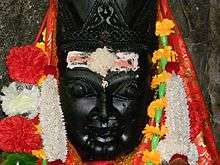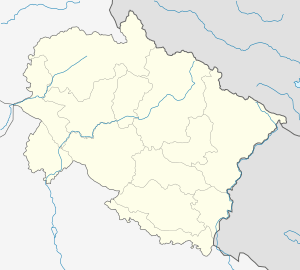Dhari Devi
Dhari Devi a temple located on the banks of the Alaknanda River between Srinagar and Rudraprayag in the Garhwal Region of Uttarakhand, India. The temple is home to the upper half of the idol of the goddess Dhari, while the lower half of the idol is located in Kalimath, where she is worshipped as a manifestation of the Goddess Kali.
| Dhari Devi | |
|---|---|
 | |
| Religion | |
| Affiliation | Hinduism |
| District | Srinagar, Uttarakhand / Rudraprayag |
| Deity | Kali (Dhari Devi) |
| Festivals | Navaratri |
| Location | |
| Location | Kalyasaur |
| State | Uttarakhand |
| Country | India |
 Location in Uttarakhand | |
| Geographic coordinates | 30.214°N 78.77592°E |
| Architecture | |
| Type | North Indian architecture |
| Elevation | 560 m (1,837 ft) |
She is considered to be the guardian deity of Uttarakhand and is revered as the protector of the Char Dham’s.[1][2] Her shrine is one of 108 Shakti Sthals in India, as numbered by Srimad Devi Bhagwat.[3]
2013 Uttarakhand floods
The original temple of the goddess was demolished on June 16, 2013, to give way to the construction of the 330 MW Alaknanda Hydro Electric Dam built by Alaknanda Hydro Power Company Ltd (AHPCL), a subsidiary of infrastructure major,K.
Incidentally, Hours after the idol was moved, the region faced what would become one of the country’s worst natural disasters since the 2004 tsunami. The 2013 North India floods were caused by a multi-day cloudburst resulting in devastating floods and landslides washing away the entire shrine town and killing hundreds of people.[4] Locals and devotees believe, Uttarakhand had to face the Goddess’ ire as she was shifted from her ‘mool sthan’ (original abode) to make way for a 330 MW hydel project that was left in ruins after the flood. A similar attempt in 1882 by a local king had resulted in a landslide that had flattened Kedarnath.[5][6]
The new temple is now being constructed at its original location.[7] To facilitate smooth operation of a 330 MW hydropower project being built in the area, the height of the temple was raised so that it stood above the gushing Alaknanda river. On the morning of June 16, 2013, the Dhari Devi shrine was removed and shifted to the concrete platform at a height of about 611 metres from the Alaknanda river so that it didn't submerge in the river. On the same evening, the devastating flashfloods hit Kedarnath."[2]
References
- "Goddess Dhari Devi's wrath behind Uttarakhand devastation, believe locals". Jagran. 25 June 2013.
- Kumar, Yogesh (26 February 2017). "Dhari devi temple on river Alaknanda awaits relocation since 3 years". The Times Of India.
- Dhari Devi Shakti Sthal, Kalyasaur Archived 28 March 2013 at the Wayback Machine
- Gusain, Raju (26 June 2013). "Superstition or co-incidence? Locals believe Kali avtaar Dhari Devi unleashed the floods for revenge". India Today.
- http://ibnlive.in.com/news/ukhand-locals-believe-moving-dhari-devi-idol-caused-the-cloudburst/402106-3-243.html
- http://zeenews.india.com/news/uttarakhand/uttarakhand-floods-dhari-devis-wrath-%E2%80%93-myth-or-reality_857295.html
- Bhatnagar, Gaurav (15 February 2017). "In Uttarakhand's Srinagar, Flood Victims Struggle While Politicians Look the Other Way". The Wire.